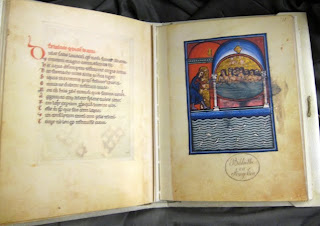When most of us plan a trip we'll consult a travel guide, a website or do a bit of surfing on the Internet. We like to know what's ahead of us - what is "worth the detour". And it was no different for early travelers to Italy or Rome. The collection at the Bibloteca Angelica contains books, maps and diaries giving tips to the visitor on a wide range of sights and subjects.
This small volume Itinerarium Puteolanensis was written and illustrated in 1240 as a guide for Frederick II when he went to visit the baths in Pozzuoli near Napoli. It extols the virtues of bathing and gives amble illustrations of the waters in the area and the benefits to be found in soaking in them.






Shortly after his death the friends of Alò Giovannoli pubished a series of 126 copper plate engravings he had made of antiquities around Rome. Though his sense of perspective and proportion is suspect he captures the ancient monuments as they were during his time (circa 1550-1618). This particular edition of the first of the three volumes of his Roma antica dates from 1661.


Above: The Arch of Titus which records the Sack of Jerusalem and still stands today - perhaps because it was incorporated into a building thus saving it from being pulled down.
Below: The Palatine Hill showing the rich gardens of the Farnese family - an effort is being made to restore them to some of their original splendor.
Below: The Palatine Hill showing the rich gardens of the Farnese family - an effort is being made to restore them to some of their original splendor.


Above: The Arch of Constantine - which is still one of the major tourist attractions - is surrounded by smaller buildings and palazzo walls.
Below: The Mausoleum of Augustus had become a public garden; in our day it has almost the appearance of rubbish heap though plans are in the works to have it restored.
Below: The Mausoleum of Augustus had become a public garden; in our day it has almost the appearance of rubbish heap though plans are in the works to have it restored.

11 febbraio - Nostra Signora di Lourdes
6 comments:
This stuff is amazing..you are the luckiest man alive!
I hope they take a hint from that last engraving and restore the Mausoleum accordingly...how beautiful.
Lokk how beautiful those are!
Makes me wonder at the hand that created them.
i'd never leave the place
Totally delicious images! Lucky you!
Thanks for the images of the Itinerarium! Glorious.
Post a Comment